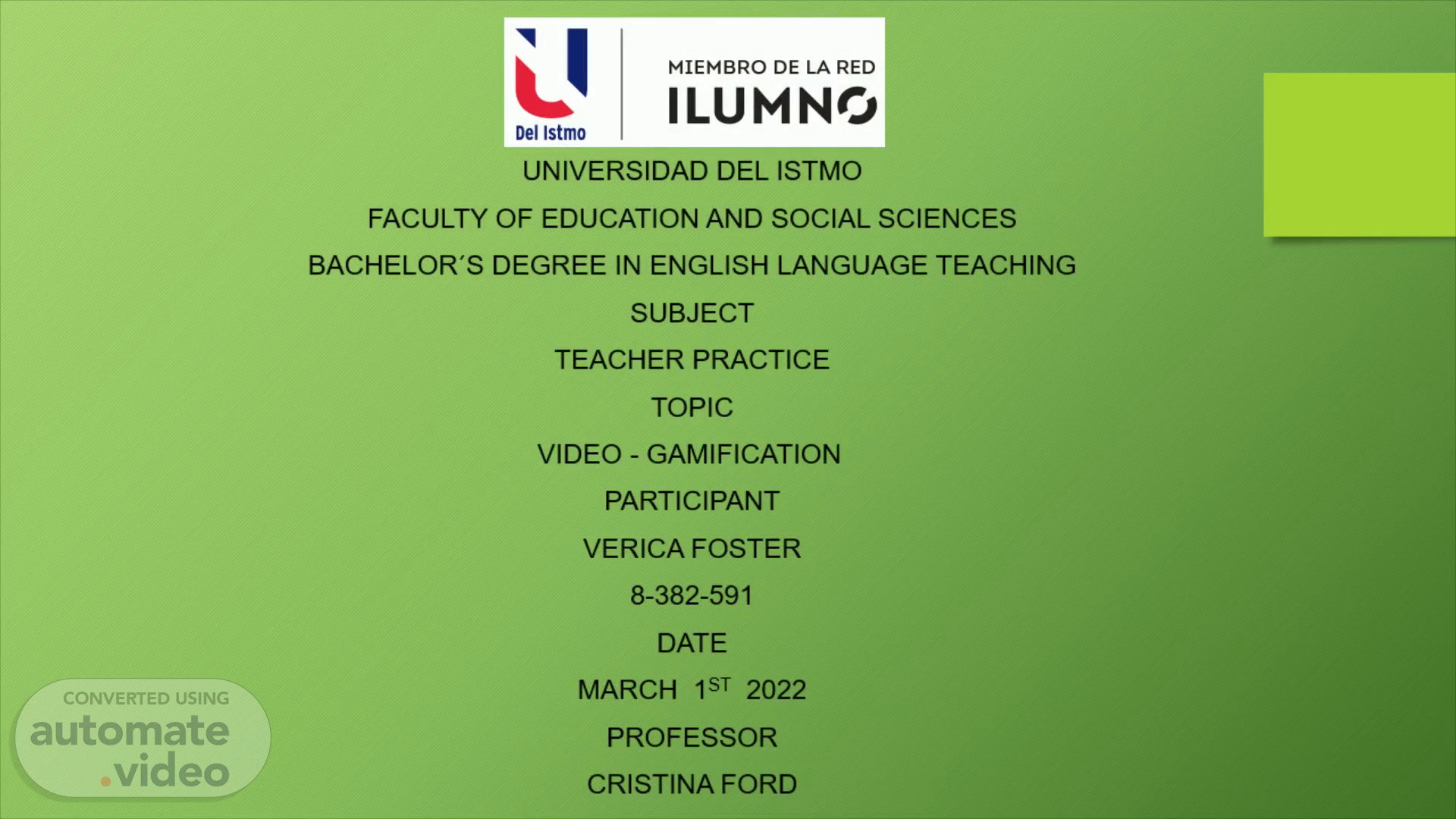
PowerPoint Presentation
Scene 1 (0s)
Universidad del Istmo catalog. UNIVERSIDAD DEL ISTMO FACULTY OF EDUCATION AND SOCIAL SCIENCES BACHELOR´S DEGREE IN ENGLISH LANGUAGE TEACHING SUBJECT TEACHER PRACTICE TOPIC VIDEO - GAMIFICATION PARTICIPANT VERICA FOSTER 8-382-591 DATE MARCH 1 ST 2022 PROFESSOR CRISTINA FORD.
Scene 2 (13s)
Introduction Today's learners are digital natives and have new profile. They grew up with digital technologies and have different learning styles, new attitude to the learning process and higher requirements for teaching and learning. Teachers are facing new challenges and have to solve important issues related to the adaptation of the learning process towards students’ needs, preferences and requirements. Teachers have to use different teaching methods and approaches that allow students to be active participants with strong motivation and engagement to their own learning. Modern pedagogical paradigms and trends in education, reinforced by the use of ICT, create prerequisites for use of new approaches and techniques in order to implement active learning. Gamification in training is one of these trends. The aim of the current work is to study and present the nature and benefits of gamification and to provide some ideas how to implement it in education..
Scene 3 (50s)
Gamification. Simply put, the definition of gamification is the use of game-design elements and game principals in non-game contexts. Gamification can also be defined as a set of activities and processes to solve problems by using the characteristics of game elements. For example, in-game principals and themes such as acquiring virtual ‘points or other currency, and completing series of tasks or activities to advance to the next level, may be used in contexts other than gaming to provide fun and stimulation for the learner..
Scene 4 (1m 14s)
Game-based learning is one teaching strategy that’s growing increasingly popular to help students achieve their learning objectives. Especially as: Students are becoming tech savvy at an earlier age Educational technology companies are developing more efficacious products. Why uses games? Games can be used to 1) reinforce concepts learned in class, 2) to create greater engagement with course material, and 3) to provide multiple methods of approaching course material. ( Gee , 2005 ) Five type of games that are used as learning- based are: board games card games word game role-playing games puzzles..
Scene 5 (1m 39s)
I choose card game, because card games help children develop their motor, cognitive and emotional skill. Playing card games is beneficial for dexterity and eye-hand coordination. The simple action of holding playing cards in their small hands helps children develop these two main motor skills . Also, it can be an excellent tool to support kids to feel confident in their communication and social interactions whether the goal with others students or feel better equipped when dealing with stressful or frustrating situations and also is constructive and helpful for building their self-esteem and confidence. The game requires patience and be able to take turns games, agreeing and sticking to the rules, and of course, being a team player – whether you win or you lose! Memory A simple set of Uno cards is great for memory, especially for young players because the they are just matching colour and number, not colour, number and 'suit' like you would with regular playing cards. This card game is an old stand-by which can be adapted for all ages and abilities of children and is great for improving concentration and memory skills. One standard deck of cards, adapted as appropriate for age and ability..
Scene 6 (2m 28s)
Instruction. Select a number of pairs of cards appropriate to the students. In this card game we will be using the game “Uno” since it has the colours and numbers ..
Scene 7 (2m 41s)
Shuffle, and spread all the cards out face down on the table between the players (you can either choose a random arrangement, or lay the cards out in grid form; the latter makes it easier to remember where cards are placed)..
Scene 8 (3m 27s)
Game-based learning vs. Gamification Game-based learning vs. Gamification Game based - learning vs Gamification.
Scene 9 (3m 39s)
CONCLUSION Game techniques and mechanisms can be implemented in the learning process as activities which purpose is to achieve certain learning objectives, increase learners’ motivation to complete them and engage students in a friendly competitive environment with other learners. Gamification is an effective approach to make positive change in students’ behavior and attitude towards learning, to improve their motivation and engagement. The results of the change have bilateral nature – they can affect students’ results and understanding of the educational content and create conditions for an effective learning process. Game-based learning is a pedagogical practice that is often difficult to implement in the classroom, but has great rewards for the instructor willing to develop the practice. The use of games can represent some of the best implementations of UDL and good educational practice, making a real difference in the lives of students..